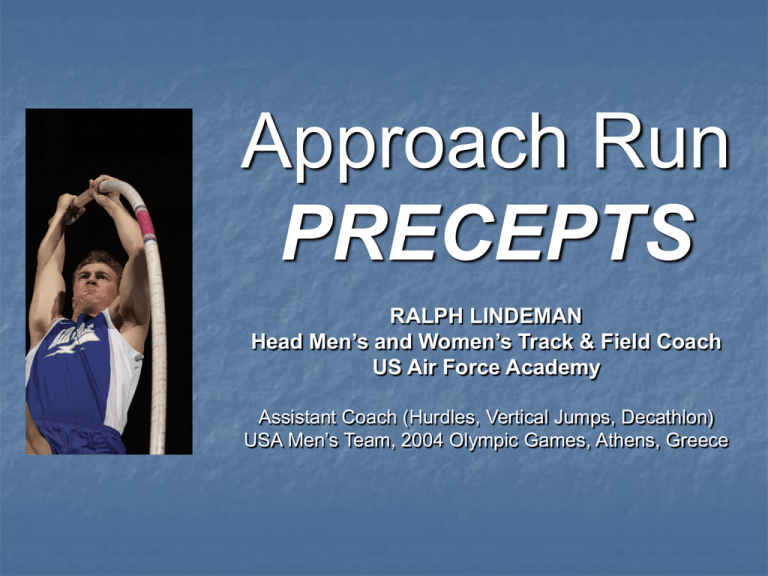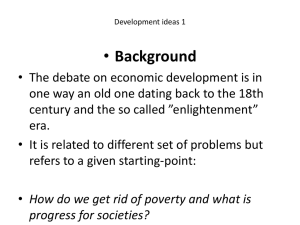Approach Run Precepts
advertisement

Approach Run PRECEPTS RALPH LINDEMAN Head Men’s and Women’s Track & Field Coach US Air Force Academy Assistant Coach (Hurdles, Vertical Jumps, Decathlon) USA Men’s Team, 2004 Olympic Games, Athens, Greece OBJECTIVES OF THE APPROACH RUN 1. Achieve maximum controllable velocity 2. Acceleration t-h-r-u take-off (Perceived) 3. Get vaulter to (precise) optimal take-off spot 4. Vertical impulse at take-off (to achieve effective take-off vector) MAXIMUM CONTROLLABLE VELOCITY Increase in approach run velocity of some magnitude will result in an increase in vault height. Research by Adamczewski and Dickwach showed that an increase in velocity of one meter per second resulted in an increase of approximately 0.5m in vault height. VELOCITY REQUIRED FOR HEIGHT ATTAINMENT Bar Clearance Height 5.80m 5.50m 5.20m 4.90m Velocity Required (19’0”) (18’0”) (17’0”) (16’0”) 9.1 m/s 8.7 m/s 8.4 m/s 8.1 m/s 4.60m (15’0”) 4.30m (14’0”) 4.00m (13’0”) 7.8 m/s 7.5 m/s 7.2 m/s 3.70m (12’0”) 6.9 m/s Interpolated from Data From Studies by Dr Peter McGinnis, Jan 2003 ACCELERATION T-H-R-U TAKE-OFF “…velocity of the vaulter between 10m to 5m from the plant box is a key indicator of the vaulter’s potential.” --Bob Fraley, Complete Book of the Jumps, p.113, Human Kinetics (1995) Why is “Acceleration through Take-off” PERCEIVED’? ACCELERATION THROUGH TAKE-OFF Competitor J Hartwig Best Ht 5.84m Velocity 15-10m 9.09 m/s Velocity 10-5m 9.45 m/s ΔV +.36 T Mack 5.74m 8.96 m/s 9.09 m/s +.13 N Hysong 5.74m 9.02 m/s 9.09 m/s +.07 T Stevenson 5.74m 9.06 m/s 9.23 m/s +.17 D Miles 5.74m 8.92 m/s 9.16 m/s +.24 From Data compiled by Dr Peter McGinnis, Men’s Pole Vault Final USA Track & Field Championships, June 22, 2002, Stanford, CA ACCELERATION THROUGH TAKE-OFF Competitor Best Ht Velocity 15-10m Velocity 10-5m ΔV S Dragila 4.65m 8.05 m/s 8.39 m/s +.34 M Sauer 4.45m 8.00 m/s 8.22 m/s +.22 M Mueller 4.40m 7.89 m/s 8.11 m/s +.22 A Wildrick 4.35m 7.45 m/s 7.50 m/s +.05 K Suttle 4.20m 7.50 m/s 7.74 m/s +.24 T O’Hara 4.20m 7.27 m/s 7.41 m/s +.14 From Data compiled by Dr Peter McGinnis, Women’s Pole Vault Final USA Track & Field Championships, June 23, 2002, Stanford, CA Common Causes of DECELERATION at Take-off Approach run may be too long; Maximum controllable velocity is reached to early in the run; Focus on the box transmits mixed signals and results in excessive steering (chopping, reaching strides) Ineffective plant technique disrupts efficient sprint mechanics WHAT HAPPENS AT TAKE-OFF? 1. Horizontal momentum transferred to pole; 2. Vertical impulse added to achieve take-off vector. VERTICAL IMPULSE AT TAKE-OFF (To Achieve Effective Take-off Vector) Effective Take-off Vector is a result of vertical impulse at take-off and horizontal momentum generated from the approach run. (a) (b) VERTICAL IMPULSE AT TAKE-OFF (To Achieve Effective Take-off Vector) * HANDS UP * EYES UP * CHEST UP * VERTICAL IMPULSE AT TAKE-OFF (To Achieve Effective Take-off Vector) (example from Long Jump) * KNEE DRIVE FORWARD & UPWARD * VERTICAL IMPULSE AT TAKE-OFF (To Achieve Effective Take-off Vector) * KNEE DRIVE FORWARD & UPWARD * VERTICAL IMPULSE AT TAKE-OFF (To Achieve Effective Take-off Vector) VERTICAL IMPULSE AT TAKE-OFF (To Achieve Effective Take-off Vector) VERTICAL IMPULSE AT TAKE-OFF (To Achieve Effective Take-off Vector) INITIATING THE RUN (Overcoming Inertia) Mechanics • With (take-off) foot in contact with the runway, raise the pole to approximately 80° by taking a short step back with the other foot • Slight lean forward to give horizontal displacement to COM INITIATING THE RUN (Overcoming Inertia) Mechanics Begin to “power” down the runway No “hops,” no “skips” Every approach run must start the same way (drills, short run, full run) RHYTHM OF THE RUN RHYTHM OF THE RUN S-m-o-o-t-h acceleration pattern (velocity curve) Short Strides Longer Strides Slow Fast Faster Faster yet SPRINT MECHANICS Two (2) Factors Affect Sprint Velocity 1. Stride Length 2. Stride Frequency SPRINT PHASES (during the Approach Run) 1. Acceleration Phase 2. Transition Phase (NOTE: Several phases have been identified in he 100m dash; but the vault run is generally between 30-45m, and maximum velocity and maintenance phases are typically not reached). SPRINT PHASES (during the Approach Run) 1. Acceleration Phase - Same mechanics as the sprinter; - Not same acceleration rate as the sprinter; - Phase is shorter distance / shorter duration than the sprinter, i.e., reached in 25-35m. 2. Transition Phase - Begins when vaulter reaches “maximum controllable velocity” - Lasts just a few strides (to penultimate stride) ACCELERATION PHASE POSTURE •Head up •Chest up •Hips underneath ACCELERATION PHASE POSTURE Head up Chest up (shoulders down results in relaxed upper body) Hips underneath Knee up (not “sitting) (knee drives up / applies forces down + back) Toe up (dorsiflexed) Heel up (high heel recovery) ACCELERATION PHASE MECHANICS “Back-side Mechanics” Predominate Power from the extensors of hip and knee; (near) full extension of hip/knee/ankle Knee drives forward & upward-applies force down & back Ground contact is made slightly behind the COM ACCELERATION PHASE MECHANICS “Back-side Mechanics” Predominate Power from the extensors of hip and knee; (near) full extension of hip/knee/ankle Knee drives forward & upward-applies force down & back Ground contact is made slightly behind the COM TRANSITION PHASE Mechanics TRANSITION PHASE Mechanics “Front-side Mechanics” dominate; Power from hip flexors & hamstrings Foot touches down slightly ahead of COM Active landings-- “feel the runway” Ground contact times decrease Posture becomes more upright (“running tall”) Heel recovery is higher (foot passes above opposite knee) TRANSITION PHASE Mechanics “Front-side Mechanics” dominate; Power from hip flexors & hamstrings Foot touches down slightly ahead of COM Active landings-- “feel the runway” Ground contact times decrease Posture becomes more upright (“running tall”) Heel recovery is higher (foot passes above opposite knee) POLE CARRY MECHANICS (During Acceleration Phase) Top hand at hip Bottom hand in front of chest Pole is pushed in advance of the vaulter, and in line with ground reaction forces. POLE CARRY MECHANICS (during Transition Phase) G-r-a-d-u-a-l pole drop accelerates with stride cadence POLE CARRY MECHANICS Errors: Effect on Sprint Mechanics Premature pole drop Carrying (instead of pushing) the pole Leaning back (to support pole) Feet land ahead of COM Braking force applied Deceleration! POLE CARRY MECHANICS Errors: Effect on Sprint Mechanics Horizontal sway (or vertical bounce) of pole Dissipates application of forces (down & back into the track) Detracts from ability to accelerate efficiently POLE CARRY MECHANICS Errors: Effect on Sprint Mechanics Pole carry too far back (i.e., top hand behind hip) Shoulders turn Dissipates application of forces Detracts from ability to accelerate efficiently POLE CARRY MECHANICS Errors: Effect on Sprint Mechanics Raised Shoulders Elevated shoulders negatively impact sprint mechanics and result in velocity loss Relaxed sprinting begins with shoulders PREPARATION FOR TAKE-OFF (“Penultimate” Stride) PREPARATION FOR TAKE-OFF What happens on “Penultimate” Stride? 2nd to last (penultimate) stride is slightly longer–lowers the COM; Last stride is slightly shorter– “catches the COM on the the rise.” PREPARATION FOR TAKE-OFF (“Penultimate” Stride) Next-to-last stride is (example from Long Jump) METHODS OF TEACHING PENULTIMATE STRIDE TECHNIQUE “Flat foot” landing on penultimate stride, “flat foot” landing on final stride – Tom Tellez “Push-pull-plant” (with take-off leg) from 2nd-to-last stride – Randy Huntington HOW CAN THE VAULTER PRACTICE PENULTIMATE STRIDE TECHNIQUE? Long Jump take-off drills. Hurdles APPROACH RUN Length Management Methods Counting Strides (“Left’s” for R-handed) Gives vaulter rhythmic feedback Helps identify phases of the approach run APPROACH RUN Length Management Methods Checkmark Systems (Works in conjunction with counting strides) Start Mark (only mark the vaulter is aware of) Mid-mark (6 strides out) Take-off (not a physical mark) APPROACH RUN Length Management Methods Value of “Mid-mark” Provides coach confirmation of “chopping,” or, more commonly, “reaching” during final strides of the approach run (“steering”) Provides coach confirmation of deceleration over the final strides of the approach run Allows coach to focus on the jump (rather than foot placement at take-off) APPROACH RUN Length Management Methods Steering Early visual pick-up of the target (box) allows for more subtle stride length changes during the steering phase. Steering ability is trainable: hurdling with variable spacing long jumping from variable approach run lengths APPROACH RUN Length Management Methods Start Mark Adustments Feedback from previous approaches Wind, runway surface Confidence, Motivation, Arousal “Feel” APPROACH RUN Length Management Methods Start Mark Adustments (No more than) 10 - 30 cm (4-12”) increments What happens to Stride Length when the sprinter (vaulter) decelerates? What happens to Stride Length when the sprinter (vaulter) decelerates? It increases! Purpose of SPEED DEVELOPMENT DRILLS Affect Stride Length Affect Stride Frequency “Backside” mechanics (i.e., pushing down the runway) (Near) full extension of hip/knee/ankle “Frontside” mechanics [i.e., driving knee forward, generating negative foot speed (whip action of foreleg)] Affect “Acceleration thru Take-off” Progression of SPEED DEVELOPMENT DRILLS “Mach Drills” A-march A-skip Double A’s Continuous A’s Progression of SPEED DEVELOPMENT DRILLS Drills for Front-side/Back-Side Mechanics A-Bounds Speed Bounds Speed Bounds w/pole Speed Bounds w/thigh weights Speed Bounds w/pole w/thigh weights Why Bounding? Progression of SPEED DEVELOPMENT DRILLS Drills for Acceleration thru Take-off 2-step Take-off Drill Run-Run-Run-Bound w/Pole Plant Sprint to Rope Plant Speed Bounds to Rope Plant Progression of SPEED DEVELOPMENT DRILLS SPEED DEVELOPMENT Physiological Basis OBJECTIVE Train the Energy System used in Pole Vault competition SPEED DEVELOPMENT Physiological Basis What Energy System is used in the Pole Vault? Anaerobic/Alactic Energy System SPEED DEVELOPMENT Physiological Basis Most Effective Method of Training the Anaerobic / Alactic Energy System: - Near-maximal velocity sprints - 3-8 seconds duration - Near full recovery, i.e., 1-3’ SPEED DEVELOPMENT Physiological Basis Why would we want to incorporate longer sprints (120’s, 150’s, 200’s) into vaulter’s training ? Speed endurance work improves efficiency of metabolic system, reducing recovery time between vaults; Longer sprints allow more conscious attention to developing efficient sprinting mechanics; Improves “general fitness”—energy efficiency, weight management, etc. Improves cardiovascular efficiency thru increased capillarization SPEED DEVELOPMENT Methods Acceleration Sprints 10-40m from standing start (both) with and without pole 1’ – 3’ recovery 250-300 meters per session SPEED DEVELOPMENT Methods Speed Development Repetitions “flying sprints” of 30-60m w/1-3 seconds at maximum velocity (both) with and without pole 4’ – 6’ recovery 400-500 meters per session SPEED DEVELOPMENT Methods Speed Endurance Repetitions 80-200m without pole 3-5’ recovery 600-900m meters per session SPEED DEVELOPMENT (Other Methods) Resisted-Sprinting (<10% loss in velocity) (Slight) uphill sprints Sled-pulling Parachute-resisted sprints SPEED DEVELOPMENT (Other Methods) Assisted-Sprinting (<10% gain in velocity) (Slight) downhill sprints Wind-aided sprints (for the vaulter, sprints w/o the pole are actually “assisted” sprints!) SPEED DEVELOPMENT (Other Methods) Pole Sprints 30-60m on the track (i.e., off the runway) w/ or w/o planting action SPEED DEVELOPMENT NEUROMUSCULAR BASIS When in the training cycle does the vaulter work on speed development? Throughout the macrocycle (training year)! Frequently in each mesocycle (training phase) At least once in each microcycle (weekly plan) At the beginning of a training session, i.e., immediately after the warm-up SPEED DEVELOPMENT NEUROMUSCULAR BASIS Fatigue cannot be allowed to become a factor in speed development training SPEED DEVELOPMENT NEUROMUSCULAR BASIS Although physiological recovery is immediate (i.e., just a few minutes), neuromuscular recovery takes 48 hours (or longer) SPEED DEVELOPMENT NEUROMUSCULAR BASIS Always finish a speed development workout with Pole Sprints— transfers “neural patterns learned” to vaulting. QUESTIONS? RALPH LINDEMAN Head Men’s and Women’s Track & Field Coach U.S AIR FORCE ACADEMY Office Phone: (719) 333-2173 ralph.lindeman@usafa.af.mil




